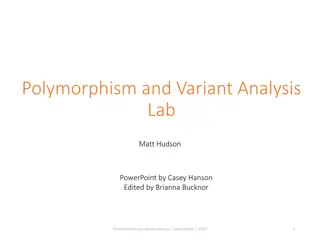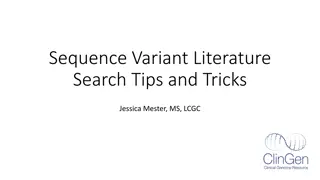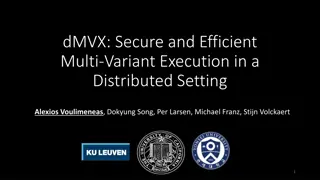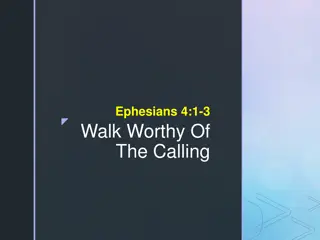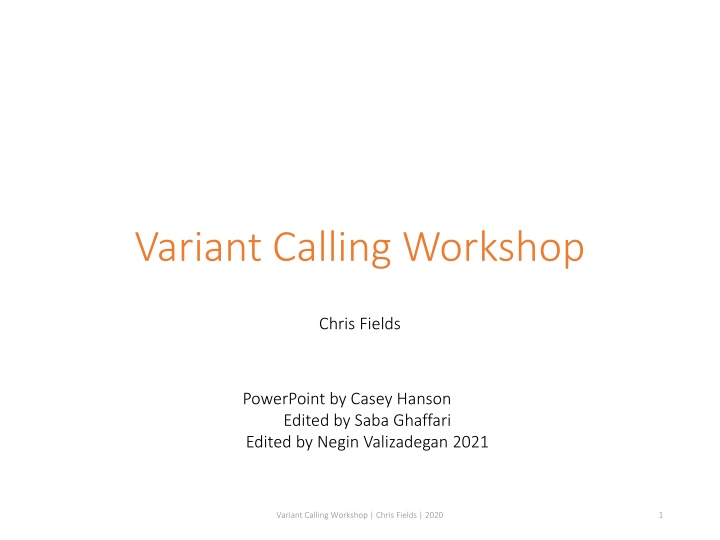
Perform Variant Calling Analysis with IGB Biocluster: Workshop Insights
Explore a detailed workshop led by Chris Fields on variant calling analysis using the IGB Biocluster. Learn to visualize results with the Integrative Genomics Viewer and follow step-by-step instructions for setting up the lab environment. Access the lab directory and understand the processes involved in variant calling. Ideal for participants interested in hands-on bioinformatics tasks.
Download Presentation

Please find below an Image/Link to download the presentation.
The content on the website is provided AS IS for your information and personal use only. It may not be sold, licensed, or shared on other websites without obtaining consent from the author. If you encounter any issues during the download, it is possible that the publisher has removed the file from their server.
You are allowed to download the files provided on this website for personal or commercial use, subject to the condition that they are used lawfully. All files are the property of their respective owners.
The content on the website is provided AS IS for your information and personal use only. It may not be sold, licensed, or shared on other websites without obtaining consent from the author.
E N D
Presentation Transcript
Variant Calling Workshop Chris Fields PowerPoint by Casey Hanson Edited by Saba Ghaffari Edited by Negin Valizadegan 2021 Variant Calling Workshop | Chris Fields | 2020 1
Introduction In this lab, we will do the following: 1. Perform variant calling analysis on the IGB biocluster. 2. Visualize our results on the desktop using the Integrative Genomics Viewer (IGV IGV) tool. Variant Calling Workshop | Chris Fields | 2020 2
Start the VM Follow instructions for starting VM. (This is the Remote Desktop software.) The instructions are different for UIUC and Mayo participants. Find the instructions for this on the course website under Lab Set-up: https://publish.illinois.edu/compgenomicscourse/2021-schedule/ Variant Calling Workshop | Chris Fields | 2020 3
Step 0A: Accessing the IGB Biocluster Open MobaXterm MobaXterm on your desktop In a new session, select SSH type the following host name: SSH and biologin.igb.illinois.edu Click OK OK 4
Step 0A: Accessing the IGB Biocluster Enter login credentials assigned to you. Example username: class100 class100. You will not see any characters on screen when typing in password. Just type it. 5
Step 0A: Accessing the IGB Biocluster If you have done this before, just double-click on the session you created once and type username and password. 6
Step 0B: Lab Setup The lab is located in the following directory: /home/classroom/mayo/2020/03_Variant_Calling/ This directory contains the data and results from the finished version of the lab (i.e. the version of the lab after the tutorial). Consult it if you unsure about your runs. You don t have write permissions to the lab directory. Create a working directory of this lab in your home directory for your output to be stored. Note ~ is a symbol in Unix paths referring to your home directory. Copy the necessary shell files (. .sh sh) files from the data directory to your working directory. Note: In this lab, we will NOT submit jobs to the biocluster. NOT login to a node on the biocluster. Instead, we will Variant Calling Workshop | Chris Fields | 2020 7
Copied Files Copied Files Step 0C: Lab Setup annotate_snpeff.sh call_variants_ug.sh Create a working directory called ~/03_Variant_Calling your home directory. ~/03_Variant_Calling in hard_filtering.sh Copy all shell files (. .sh working directory. sh) from the follwing path to your post_annotate.sh $ mkdir ~/03_Variant_Calling # Make working directory in your home directory $ cd ~/03_Variant_Calling # Change directory to your working directory. $ cp /home/classroom/hpcbio/mayo_workshop/2019/Mayo-Variant-Calling/*.sh . # Copy shell files to your working directory. Variant Calling Workshop | Chris Fields | 2020 8
Variant Calling Setup In this exercise, we will use data from the 1000 Genomes project (EXOME, 60x coverage) to call variants, in particular single nucleotide polymorphisms. The initial part of the GATK pipeline (alignment, local realignment, base quality score alignment, local realignment, base quality score recalibration recalibration) has been done, and the BAM file has been reduced for a portion of human chromosome 20. This is the data we will be working with in this exercise. Variant Calling Workshop | Chris Fields | 2020 9
Step 1A: Running a Variant Calling Job In this step, we will start a variant calling job using the sbatch sbatch command. Additionally, we will gather statistics about our job using the squeue squeue command. $ sbatch call_variants_ug.sh # This will execute call_variants_ug.sh on the biocluster. $ squeue -u $USER # Get statistics on your submitted job Variant Calling Workshop | Chris Fields | 2020 10
Step 1B: Output of Variant Calling Job Periodically, call squeue finished. squeue to see if your job has Files Files raw_indels.vcf You should have 4 4 files when it has completed. raw_indels.vcf.idx raw_snps.vcf Discussion Discussion raw_snps.vcf.idx - What did we just do? We ran the GATK GATK UnifiedGenotyper UnifiedGenotyper to call variants. Look at the file structure. Variant Calling Workshop | Chris Fields | 2020 11
Step 1C: SNP and Indel Counting In this step, we will count the # of SNPS and Indels identified in the raw_snps.vcf raw_snps.vcf and raw_indels.vcf raw_indels.vcf files. We will use grep grep, which is a text matching program. $ grep -c -v '^#' raw_snps.vcf # Get the number of SNPs. # -v Tells grep to show all lines not beginning with # in raw_snps.vcf. # -c Tells grep to return the total number of returned lines. # Output should be approx. 14400. $ grep -c -v '^#' raw_indels.vcf # Get the number of indels. # Output should be approx. 1069. Variant Calling Workshop | Chris Fields | 2020 12
Step 1D: SNP and Indel Counting in dbSNP In this step, we will count the number of SNPs and Indels in dbSNP. dbSNP SNPs and Indels have the rs# rs# identifier where # is a number. Example: rs1000 $ grep -c 'rs[0-9]*' raw_snps.vcf # Get the number of dbSNP SNPs. # Return all lines in raw_snps.vcf containing rs followed by a number. # -c Tells grep to return the total number of returned lines. # Output should be approx. 12650. $ grep -c 'rs[0-9]*' raw_indels.vcf # Get the number of dbSNP indels. # Output should be approx. 958. Variant Calling Workshop | Chris Fields | 2020 13
Step 2A: Hard Filtering Variant Calls We need to filter these variant calls in some way. In general, we would filter on quality scores. However, since we have a very small set of variants, we will use hard filtering. Output Files Output Files $ sbatch hard_filtering.sh # Execute hard_filtering.sh on the biocluster. hard_filtered_snps.vcf hard_filtered_snps.vcf $ squeue -u $USER hard_filtered_indels.vcf hard_filtered_indels.vcf Periodically, call Periodically, call squeue squeue to see if your job has finished to see if your job has finished. Variant Calling Workshop | Chris Fields | 2020 14
Step 2A: Hard Filtering Variant Calls **Do not need to run this code** **Do not need to run this code** gatk -T VariantFiltration \ Hard filtering steps use specific cutoffs with annotations for filtering data, labeling them according to any filters that a variant doesn t pass. In the lecture we discuss ways to look at samples and assess a cutoff Here we use example cutoffs recommended by GATK group -R $REFERENCE \ --variant $SNP_VCF_FILE \ --clusterSize 3 \ # 3 SNPs within --clusterWindowSize 10 \ # 10nt window --filterExpression "QD < 2.0" \ # Condition --filterName "QDFilter" \ # Label --filterExpression "MQ < 40.0" \ --filterName "MQFilter" \ --filterExpression "FS > 60.0" \ --filterName "FSFilter" \ --filterExpression "HaplotypeScore > 13.0" \ --filterName "HaplotypeScoreFilter" \ --filterExpression "MQRankSum < -12.5" \ --filterName "MQRankSumFilter" \ --filterExpression "ReadPosRankSum < -8.0" \ --filterName "ReadPosRankSumFilter" \ -o $SNP_VCF_FILE_OUT Variant Calling Workshop | Chris Fields | 2020 15
Step 2B: Hard Filtering Variants Calls In this step, we will count the # of filtered SNPs and Indels. $ grep -c 'PASS' hard_filtered_snps.vcf # Count # of passes # Output 8554. $ grep -c 'PASS' hard_filtered_indels.vcf # Count # of PASSES # Output 1069 Discussion Discussion 1. Did we lose any variants? 2. How many PASSED the filter? 3. What is the difference in the filtered and raw input? 4. Why are these approximate (why do results slightly differ)? Variant Calling Workshop | Chris Fields | 2020 16
Step 2B: Hard Filtering Variants Calls Some of the filters are as following: QD: QD: variant confidence/ quality by depth, QD < 2 MQ: MQ: RMS mapping quality, MQ < 40 FS: FS: Phred-scaled p-value, FS > 60.0 QD < 2 MQ < 40 FS > 60.0 - What is the difference in the filtered and raw input? In the filtered input the FORMAT column has information on whether the SNP has passed all the filters ( PASS ) or has failed any of them. Variant Calling Workshop | Chris Fields | 2020 17
Step 3A: Annotating Variants With SnpEff With our filtered variants, we now need to annotate them with SnpEff SnpEff. . SnpEff SnpEff adds information about where variants are in relation to specific genes. Periodically, call Periodically, call squeue squeue to see if your job has finished to see if your job has finished. Output Files Output Files $ sbatch annotate_snpeff.sh hard_filtered_snps_annotated.vcf hard_filtered_snps_annotated.vcf # This will execute snpeff.sh on the biocluster. hard_filtered_indels_annotated.vcf hard_filtered_indels_annotated.vcf $ squeue -u $USER Variant Calling Workshop | Chris Fields | 2020 18
Step 3B: Annotating Variants With SnpEff The IDs for the human assembly version we use are from Ensemble. The Ensemble format is ENSG ENSGXXXXXXXXXXX. XXXXXXXXXXX. Example: FOXA2 s Ensemble ID is ENSG00000125798. In this step, we would like to see if there are any variants of FOXA2. $ grep -c 'ENSG00000125798' hard_filtered_snps_annotated.vcf # Get the number of SNPS in FOXA2, ENSG00000125798. # Output should be 3. $ grep -c 'ENSG00000125798' hard_filtered_indels_annotated.vcf # Get the number of Indels in FOXA2, ENSG00000125798. # Output should be 0. Variant Calling Workshop | Chris Fields | 2020 19
Step 4: GATK Variant Annotator SnpEff SnpEff adds a lot of information to the VCF. GATK Variant Annotator helps remove a lot of the extraneous information. $ sbatch post_annotate.sh # This will execute post_annotate.sh on the biocluster. $ squeue -u $USER Variant Calling Workshop | Chris Fields | 2020 20
Exit MobaXterm by either closing the window or typing exit in the command prompt. Variant Calling Workshop | Chris Fields | 2020 21
Visualization of Results In this exercise, we will visualize the results of the previous exercise using the Integrated Genomics Viewer (IGV). Integrated Genomics Viewer (IGV). We are going to do visualization on VM. We are going to do visualization on VM. Variant Calling Workshop | Chris Fields | 2020 22
Step 0: Local Files (for for UIUC UIUC users users) **If you are a Mayo Clinic user, go to the next slide** **If you are a Mayo Clinic user, go to the next slide** For viewing and manipulating the files needed for this laboratory exercise, the path on the VM will be denoted as the following: [course_directory] We will use the files found in: [course_directory]\03_Variant_Calling\results For UIUC: [course_directory]= C:\Users\IGB\Desktop\VM so the path would be: C:\Users\IGB\Desktop\VM\03_Variant_Calling\results Genome Assembly | Saba Ghaffari | 2020 23
Step 0: Local Files (for for Mayo Clinic Mayo Clinic users users) For viewing and manipulating the files needed for this laboratory exercise, the path on the VM will be denoted as the following: [course_directory] We will use the files found in: [course_directory]\03_Variant_Calling\results For Mayo Clinic:[course_directory]= C:/Users/Public/Desktop/VM so the path would be: C:\Users\Public\Desktop\VM\03_Variant_Calling\results Genome Assembly | Saba Ghaffari | 2020 24
Step 5A: Visualization With IGV Switch the genome to Human (b37) Human (b37). Variant Calling Workshop | Chris Fields | 2020 25
Step 5B: Loading VCF Files On the menu bar, click File File Click Load from File Load from File Navigate to: [course_directory]/03_Variant_Calling/results Hold the Ctrl Ctrl key down. Click both vcf vcf files. Click Open. Open. Variant Calling Workshop | Chris Fields | 2020 26
Step 5C: Loading VCF Files You should see a windows similar to below: Variant Calling Workshop | Chris Fields | 2020 27
Step 5D: Navigate to Chromosome 20 In the search box, type chr20 chr20. Press Enter Enter or click Go. Go. You should see a track similar to the screenshot on the right. Variant Calling Workshop | Chris Fields | 2020 28
Step 5E: Navigate to Chromosome 20 Click and drag from around the 20 20 mb mb mark to about the 27 27 mb mb mark. Variant Calling Workshop | Chris Fields | 2020 29
Step 5F: Navigate to Chromosome 20 The result should look similar to the screenshot below: Variant Calling Workshop | Chris Fields | 2020 30
Step 5G: Setting Feature Visibility Window Do this for each VCF track: Do this for each VCF track: Right Click Right Click and Select Set Feature Visibility Window Window Set Feature Visibility Enter 10000 10000 (which is 10 Mb). Click OK. OK. Variant Calling Workshop | Chris Fields | 2020 31
Step 5H: Viewing FOXA2 Polymorphisms In the search box, type FOXA2 FOXA2 and press Enter. Enter. You should see something like the window below: Variant Calling Workshop | Chris Fields | 2020 32
Checkpoint: FOXA2 Polymorphisms 1. How many SNPs are here? 2. How many Indels are here? 3. How many SNPs are heterozygotes? Variant Calling Workshop | Chris Fields | 2020 33
Step 6A: Loading a BAM File On the menu bar, click File File Click Load from File Load from File Navigate to: [course_directory]/03_Variant_Calling/results Hold the Ctrl Ctrl key down. Click the bam bam file. Click Open. Open. Variant Calling Workshop | Chris Fields | 2020 34
Step 6B: Loading BAM File You should see a window with a new track similar to the one below: Variant Calling Workshop | Chris Fields | 2020 35
Step 6C: Show Coverage Track Note: If you don't see a summary track like below : Note: If you don't see a summary track like below : Right Click Click on the BAM BAM track. Click Show Coverage Track Show Coverage Track. Variant Calling Workshop | Chris Fields | 2020 36
Step 6D: Color Alignments by Read Right Click Click on the BAM BAM track. Click Color Alignment by Color Alignment by and then Read Strand Read Strand Variant Calling Workshop | Chris Fields | 2020 37
Step 6E: FOXA2 Read GAP Question What is happening in the highlighted portion? Variant Calling Workshop | Chris Fields | 2020 38
Step 6F: Viewing SNP Calls Zoom In (double click) on SNPs to see the base pair calls on each read. Variant Calling Workshop | Chris Fields | 2020 39
Step 7: SnpEff Results SnpEff gives a nice summary HTML file. Navigate to the results directory for this lab: [course_directory]/03_Variant_Calling/results Open snpEff_summary.html in each of the following sub directories: 1. snpeff_snp_results 2. snpeff_indel_results Browse each of the HTML files and note the results of the following slides: Variant Calling Workshop | Chris Fields | 2020 40
Step 7B: SNPEff Summary of SNPS Variant Calling Workshop | Chris Fields | 2020 41
Step 7B: SNPEff Summary of Indel Lengths The summary of snpeff lengths: snpeff indels indels shows the following distribution of indel Variant Calling Workshop | Chris Fields | 2020 42


